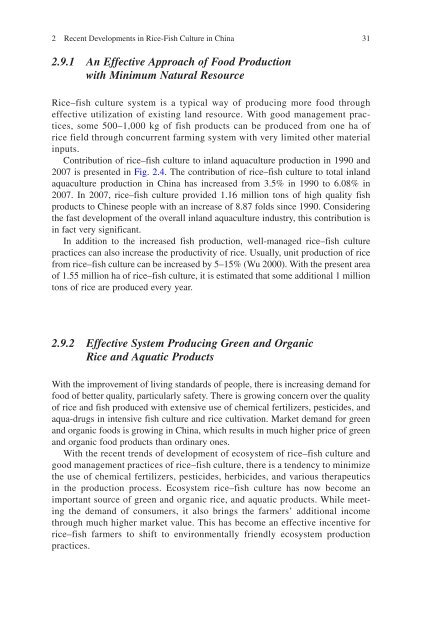Success Stories In Asian Aquaculture - Library - Network of ...
Success Stories In Asian Aquaculture - Library - Network of ...
Success Stories In Asian Aquaculture - Library - Network of ...
- No tags were found...
You also want an ePaper? Increase the reach of your titles
YUMPU automatically turns print PDFs into web optimized ePapers that Google loves.
2 Recent Developments in Rice-Fish Culture in China312.9.1 An Effective Approach <strong>of</strong> Food Productionwith Minimum Natural ResourceRice–fish culture system is a typical way <strong>of</strong> producing more food througheffective utilization <strong>of</strong> existing land resource. With good management practices,some 500–1,000 kg <strong>of</strong> fish products can be produced from one ha <strong>of</strong>rice field through concurrent farming system with very limited other materialinputs.Contribution <strong>of</strong> rice–fish culture to inland aquaculture production in 1990 and2007 is presented in Fig. 2.4 . The contribution <strong>of</strong> rice–fish culture to total inlandaquaculture production in China has increased from 3.5% in 1990 to 6.08% in2007. <strong>In</strong> 2007, rice–fish culture provided 1.16 million tons <strong>of</strong> high quality fishproducts to Chinese people with an increase <strong>of</strong> 8.87 folds since 1990. Consideringthe fast development <strong>of</strong> the overall inland aquaculture industry, this contribution isin fact very significant.<strong>In</strong> addition to the increased fish production, well-managed rice–fish culturepractices can also increase the productivity <strong>of</strong> rice. Usually, unit production <strong>of</strong> ricefrom rice–fish culture can be increased by 5–15% (Wu 2000). With the present area<strong>of</strong> 1.55 million ha <strong>of</strong> rice–fish culture, it is estimated that some additional 1 milliontons <strong>of</strong> rice are produced every year.2.9.2 Effective System Producing Green and OrganicRice and Aquatic ProductsWith the improvement <strong>of</strong> living standards <strong>of</strong> people, there is increasing demand forfood <strong>of</strong> better quality, particularly safety. There is growing concern over the quality<strong>of</strong> rice and fish produced with extensive use <strong>of</strong> chemical fertilizers, pesticides, andaqua-drugs in intensive fish culture and rice cultivation. Market demand for greenand organic foods is growing in China, which results in much higher price <strong>of</strong> greenand organic food products than ordinary ones.With the recent trends <strong>of</strong> development <strong>of</strong> ecosystem <strong>of</strong> rice–fish culture andgood management practices <strong>of</strong> rice–fish culture, there is a tendency to minimizethe use <strong>of</strong> chemical fertilizers, pesticides, herbicides, and various therapeuticsin the production process. Ecosystem rice–fish culture has now become animportant source <strong>of</strong> green and organic rice, and aquatic products. While meetingthe demand <strong>of</strong> consumers, it also brings the farmers’ additional incomethrough much higher market value. This has become an effective incentive forrice–fish farmers to shift to environmentally friendly ecosystem productionpractices.
















